Analysis of the Evolution of Lowland Landslides in Temperate Environments According to Climatic Conditions Based on LiDAR Data: A Case Study from Rilly (Champagne Vineyard Region, Northeastern France)
Abstract
1. Introduction
2. Study Area
3. Materials and Methods
4. Results
5. Discussion
6. Conclusions
Author Contributions
Funding
Data Availability Statement
Conflicts of Interest
Abbreviations
| BRGM | Bureau de Recherches Géologiques et Minières |
| ONF | Office Nationale des Forêts |
| CIVC | Comité Interprofessionnel des Vins de Champagne |
References
- Dikau, R.; Cavallin, A.; Jäger, S. Databases and GIS for landslide research in Europe. Geomorphology 1996, 15, 227–239. [Google Scholar] [CrossRef]
- Djuric, N.; Besevic, M.; Djuric, D.; Prokic, A.; Kukaras, D. Causes and Consequances of Certain Landslides in Republic of Srpska, Bosnia and Herzegovina. Procedia Earth Planet. Sci. 2015, 15, 159–164. [Google Scholar] [CrossRef][Green Version]
- Prodan, M.V.; Peranic, J.; Jagodnik, V.; Setiawan, H.; Arbans, Z. Influence of precipitation and soil conditions on the Krbavcici landslide reactivation (Istria Peninsula, Croatia). In Proceedings of the 6th Regional Symposium on Landslides, Belgrade, Serbia, 15–18 May 2024. [Google Scholar] [CrossRef]
- Demoulin, A.; Pissart, A.; Schroeder, C. On the origin of late Quaternary palaeolandslides in the Liège (E Belgium) area. Int. J. Earth Sci. 2003, 92, 795–805. [Google Scholar] [CrossRef]
- Hadji, R.; Boumazbeur, A.; Limani, Y.; Baghem, M.; Chouabi, A.-M.; Demdoum, A. Geologic, topographic and climatic controls in landslide hazard assessment usgin GIS modeling: A case study of Souk Ahras region, NE Algeria. Quat. Int. 2013, 302, 224–237. [Google Scholar] [CrossRef]
- Fang, Z.; Barasal Morales, A.; Wang, Y.; Lombardo, L. Climate change has increased rainfall-induced landslide damages in central China. Int. J. Disaster Risk Reduct. 2025, 119, 105320. [Google Scholar] [CrossRef]
- Ramzan, M.; Cui, P.; Ualiyeva, D.; Mukhtar, H.; Bazai, N.A.; Baig, M.A. Impact of climate change on landslides along N-15 Highway, northern Pakistan. Adv. Clim. Change Res. 2025, in press. [Google Scholar] [CrossRef]
- Panek, T.; Hradecky, J.; Smolkova, V.; Silhan, K. Giant ancient landslide in the Alma water gap (Crimean Mountains, Ukraine): Notes to the predisposition structure, and chronology. Landslides 2008, 5, 367–378. [Google Scholar] [CrossRef]
- Panek, T.; Hradecky, J.; Smolkova, V.; Silhan, K. Gigantic low-gradient landslides in the northern periphery of the Crimean Mountains (Ukraine). Geomorphology 2008, 95, 449–473. [Google Scholar] [CrossRef]
- Preuth, T.; Glade, T.; Demoulin, A. Stability analysis of a human-influenced landslide in eastern Belgium. Geomorphology 2010, 120, 38–47. [Google Scholar] [CrossRef]
- Vranken, L.; Van Turnhout, P.; Van Den Eeckhaut, M.; Vanderkerckhove, L.; Poesen, J. Economic valuation of landslide damage in hilly regions: A case study from Flanders, Belgium. Sci. Total Environ. 2013, 447, 323–336. [Google Scholar] [CrossRef]
- Bollot, N.; Devos, A.; Pierre, G. Ressources en eau et glissements de terrain: Exemple du bassin versant de la Semoigne (bassin de Paris, France). Géomorphologie: Relief, Processus. Environnement 2015, 2, 121–132. [Google Scholar] [CrossRef]
- Berthe, J. Apport du LiDAR Aéroporté à la Comprehension des Hydrosystèmes—Exemple de la Montagne de Reims. Ph.D. Thesis, Université de Reims Champagne-Ardenne, Reims, France, 2024; 412p. [Google Scholar]
- Ortonovi, S.; Bollot, N. Modélisation des glissements de terrain du vignoble champenois. Vign. Champen. 2019, 9, 37–42. [Google Scholar]
- Ortonovi, S.; Bollot, N.; Pierre, G.; Devos, A.; Perarnau, R. Dynamique et modelé des versants cambrés de la vallée de l’Ardre (plateau éocène du Soissonnais, bassin de Paris, France). Géomorphol. Relief Process. Environ. 2020, 26, 117–126. [Google Scholar] [CrossRef]
- Ortonovi, S.; Bollot, N.; Pierre, G.; Deroin, J.-P. Cartographie de la susceptibilité aux glissements de terrain dans le vignoble champenois entre Epernay et Dormans (France): Apport de la télédétection multispectrale. Géomorphol. Relief Process. Environ. 2021, 27, 147–158. [Google Scholar] [CrossRef]
- Bollot, N.; Pierre, G.; Grandjean, G.; Fronteau, G.; Devos, A.; Lejeune, O. Internal structure and reactivations of a mass movement: The case study of the Jacotines landslide (Champagne vineyards, France). GeoHazards 2023, 4, 183–196. [Google Scholar] [CrossRef]
- Li, X.; Zhao, C.; Hölter, R.; Datcheva, M.; Lavasan, A. Modelling of a large landslide problem under water level fluctuation—Model calibration and verification. Geosciences 2019, 9, 89. [Google Scholar] [CrossRef]
- Zhang, X.; Xu, C.; Li, L.; Feng, L.; Yang, W. Inventory of Landslides in the Northern Half of the Taihang Mountain Range, China. Geosciences 2024, 14, 74. [Google Scholar] [CrossRef]
- Xiong, L.; Wang, G.; Bao, Y.; Zhou, X.; Sun, X.; Zhao, R. Detectability of repeated airborne laser scanning for mountain landslide monitoring. Geosciences 2018, 8, 469. [Google Scholar] [CrossRef]
- Cai, J.; Zhang, L.; Dong, J.; Dong, X.; Li, M.; Xu, Q.; Liao, M. Detection and characterization of slow-moving landslides in the 2017 Jiuzhaigou earthquake area by combining satellite SAR observations and airborne Lidar DSM. Eng. Geol. 2022, 305, 106730. [Google Scholar] [CrossRef]
- Laurain, M.; Guérin, H.; Durand, R.; Chertier, B.; Louis, P.; Marfaux, P.; Neiss, R. Note explicative de la feuille de Reims au 1/50,000. In Carte Géologique de France; BRGM: Orléans, France, 1981; p. 132. [Google Scholar]
- Cozeret, O. Les mouvements de terrain dans le secteur de Champillon-Dizy-Hautvillers (Marne). Trav. L’institut Géogr. Reims 1987, 69–72, 129–150. [Google Scholar] [CrossRef]
- Marre, A. Le mouvement de terrain de Rilly-la-Montagne du 23 août 1986, naissance et évolution. Trav. L’institut Géogr. Reims 1987, 69–72, 95–111. [Google Scholar] [CrossRef]
- Bollot, N.; Pierre, G.; Devos, A.; Lutz, P.; Ortonovi, S. Hydrogeology of a landslide: A case study in the Montagne de Reims (Paris basin, France). Quaterly J. Eng. Geol. Hydrogeol. 2022, 56, 2021–2041. [Google Scholar] [CrossRef]
- Jomard, H.; Lebourg, T.; Binet, S.; Tric, E.; Hernandez, M. Characterization of an internal slope movement structure by hydrogeophysical surveying. Terra Nova 2007, 19, 48–57. [Google Scholar] [CrossRef]
- De Bari, C.; Lapenna, V.; Perrone, A.; Puglisi, C.; Sdao, F. Digital photogrammetric analysis and electrical resistivity tomography for investigating the Picerno landslide (Basilicata region, southern Italy). Geomorphology 2011, 133, 34–46. [Google Scholar] [CrossRef]
- Grandjean, G.; Gourry, J.C.; Sanchez, O.; Bitri, A.; Garambois, S. Structural study of the Ballandaz landslide (French Alps) using geophysical imagery. J. Appl. Geophys. 2011, 75, 531–542. [Google Scholar] [CrossRef]
- Uhlemann, S.; Chambers, J.; Wilkinson, P.; Maurer, H.; Merritt, A.; Meldrum, P.; Kuras, O.; Gunn, D.; Smith, A.; Dijkstra, T. Four-dimensional imaging of moisture dynamics during landslide reactivation. J. Geophys. Res. Earth Surf. 2017, 122, 398–418. [Google Scholar] [CrossRef]
- Hu, S.; Wang, X.; Wang, N.; Yang, D.; Wang, D.; Ma, S.; Song, Z.; Cao, M. Dynamic process, influence, and triggering mechanism of slope remodelling by landslide clusters in the South Jingyang Tableland, China. Catena 2022, 217, 106518. [Google Scholar] [CrossRef]
- Jongmans, D.; Bièvre, G.; Renalier, F.; Schwartz, S.; Beaurez, N.; Orengo, Y. Geophysical investigation of a large landslide in glaciolacustrine clays in the Trièves area (French Alps). Eng. Geol. 2009, 109, 45–56. [Google Scholar] [CrossRef]
- Colangelo, G.; Lapenna, V.; Perrone, A.; Piscitelli, S.; Telesca, L. 2D Self-Potential tomographies for studying groundwater flows in the Varco d’Izzo landslide (Basilicata, southern Italy). Eng. Geol. 2006, 88, 274–286. [Google Scholar] [CrossRef]
- Göktürkler, G.; Balkaya, C.; Erhan, Z. Geophysical investigation of a landslide: The Altindag landslide site, Izmir (western Turkey). J. Appl. Geophys. 2008, 65, 84–96. [Google Scholar] [CrossRef]
- Gance, J.; Grandjean, G.; Samyn, K.; Malet, J.-P. Quasi-Newton inversion of seismic first arrivals using source finite bandwidth assumption: Application to subsurface characterization of landslides. J. Appl. Geophys. 2012, 87, 94–106. [Google Scholar] [CrossRef]
- Beltrando, G.; Bridier, S.; Madelin, M.-H.; Queno, H. Evaluation de l’impact d’un futur remblai de la ligne à grande vtesse Est Européenne sur le risque de gel dans le vignoble de Champagne. Hommes Terres Nord 2002, 1, 40–52. [Google Scholar] [CrossRef]
- Madelin, M.-H.; Beltrando, G.; Langellier, F.; Camblan, M. Amélioration de la prévision des gelées printanières dans le vignoble de la Marne en Champagne. Hommes Terres Nord 2002, 1, 53–62. [Google Scholar] [CrossRef]
- Briche, E.; Quenol, H.; Beltrando, G. Changement climatique dans le vignoble champenois. L’année 2003, préfigure t-elle les prévisions des modèles numériques pour le XXIème siècle? L’espace Géogr. 2011, 2, 164–175. [Google Scholar] [CrossRef]
- Mora, O.; Lenzano, M.-G.; Toth, C.-K.; Grejner-Brzezinska, A.; Fayne, J.-V. Landslide change detection based on multu-temporal airborne LiDAR-Derived DEMs. Geosciences 2018, 8, 23. [Google Scholar] [CrossRef]
- Azmoon, B.; Biniyaz, A.; Liu, Z. Use of High-Resolution Multi Temporel DEM Data for landslide detection. Geosciences 2022, 12, 378. [Google Scholar] [CrossRef]
- Berthe, J.; Devos, A.; Lejeune, O.; Bollot, N.; Fronteau, G.; Perarnau, R.; Ortonovi, S. Apport du LiDAR aéroporté sur la compréhension des facteurs d’exokarstification en contexte de bas plateau, exemple de la Montagne de Reims (France). Géomorphologie Relief Process. Environ. 2022, 28, 207–221. [Google Scholar] [CrossRef]
- Hu, S.; Qiu, H.; Wang, X.; Gao, Y.; Wang, N.; Wu, J.; Yang, D.; Cao, M. Acquiring high-resolution topography and performing spatial analysis of loess landslides by using low-cost UAVs. Landslides 2018, 15, 593–612. [Google Scholar] [CrossRef]
- Brezny, M.; Panek, T. Deep-seated landslides affecting monoclinal flysch morphostructure: Evaluation of LiDAR-derived topography of the highest range of the Czech Carpathians. Geomorphology 2017, 285, 44–57. [Google Scholar] [CrossRef]
- Chalupa, V.; Panek, T.; Silhan, K.; Brezny, M.; Tichavsky, R.; Grygar, R. Low-topography deep-seated gravitational slope deformation: Slope instability of flysch thrust fronts (Outer Western Carpathians). Geomorphology 2021, 389, 107833. [Google Scholar] [CrossRef]
- Panek, T.; Klimes, J. Temporal behavior of deep-seated gravitational slope deformations: A review. Earth-Sci. Rev. 2016, 156, 14–38. [Google Scholar] [CrossRef]
- Fernandez, T.; Perez, J.-L.; Colomo, C.; Cardenal, J.; Delgado, J.; Palenzuela, J.-A.; Irigaray, C.; Chacon, J. Assessment of the evolution of a landslide using digital photogrammetry and LiDAR techniques in the Alpujarras region (Granada, Southeastern Spain). Geosciences 2017, 7, 32. [Google Scholar] [CrossRef]
- Koshimizu, K.; Uchida, T. Time-Series Variation of Landslide Expansion in Areas with a Low Frequency of Heavy Rainfall. Geosciences 2023, 13, 314. [Google Scholar] [CrossRef]
- Gonzalez Diez, A.; Salas, L.; Diaz de Teran, J.R.; Cendrero, A. Late Quaternary climate changes and mass movement frequency and magnitude in the Cantabrian region, Spain. Geomorphology 1996, 15, 290–309. [Google Scholar] [CrossRef]
- Soldati, M.; Corsini, A.; Pasuto, A. Landslides and climate change change in the Italian Dolomites since the Late Glacial. Catena 2004, 55, 141–161. [Google Scholar] [CrossRef]
- Panek, T.; Margielewski, W.; Taborik, P.; Urban, J.; Hradecky, J.; Szura, C. Gravitationally induced caves and other discontinuities detected by 2D electrical resistivity tomography: Case studies from the Polish Flysch Carpathians. Geomorphology 2010, 123, 165–180. [Google Scholar] [CrossRef]
- Dapples, F.; Lotter, A.F.; van Leeuwen, J.F.N.; van der Knaap, W.O.; Dimitriadis, S.; Oswald, D. Peleolimnological evidence for increased landslide activity due to forest clearing and land-use since 3600 cal BP in the western Swiss Alps. J. Paleolimnol. 2002, 27, 239–248. [Google Scholar] [CrossRef]
- Remondo, J.; Soto, J.; Gonzalez Diez, A.; Diaz de Teran, J.R.; Cendrero, A. Human impact on geomorphic processes and hazards in mountain areas in northern Spain. Geomorphology 2005, 66, 69–84. [Google Scholar] [CrossRef]
- Van Den Eeckhaut, M.; Marre, A.; Poesen, J. Comparison of two landslide susceptibility assessments in the Champagne-Ardenne region (France). Geomorphology 2010, 11, 141–155. [Google Scholar] [CrossRef]
- Wu, S.-J.; Chen, S.-R.; Wang, C.-D. Modeling ANN-Based Estimations of Probabilistic-Based Failure Soil Depths for Rainfall-Induced Shallow Landslides Due to Uncertainties in Rainfall Factors. Geosciences 2025, 15, 88. [Google Scholar] [CrossRef]

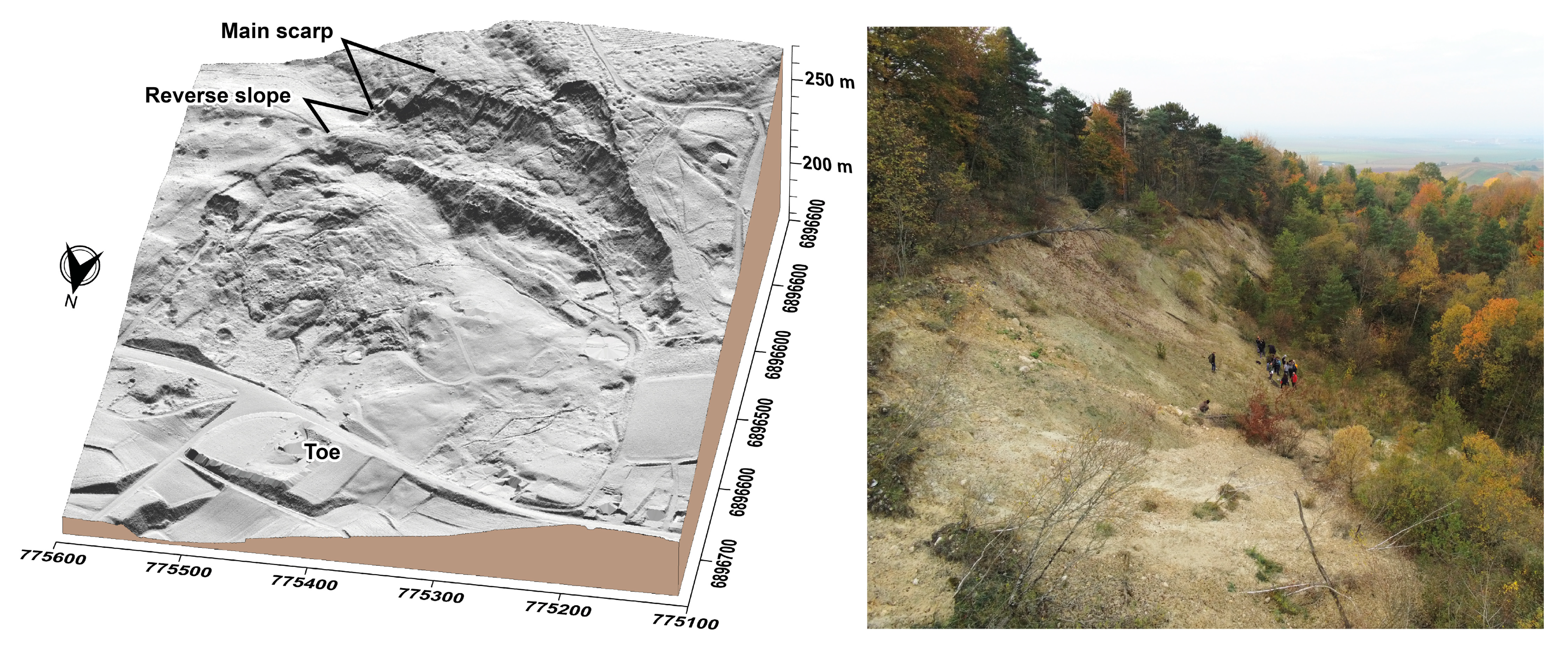
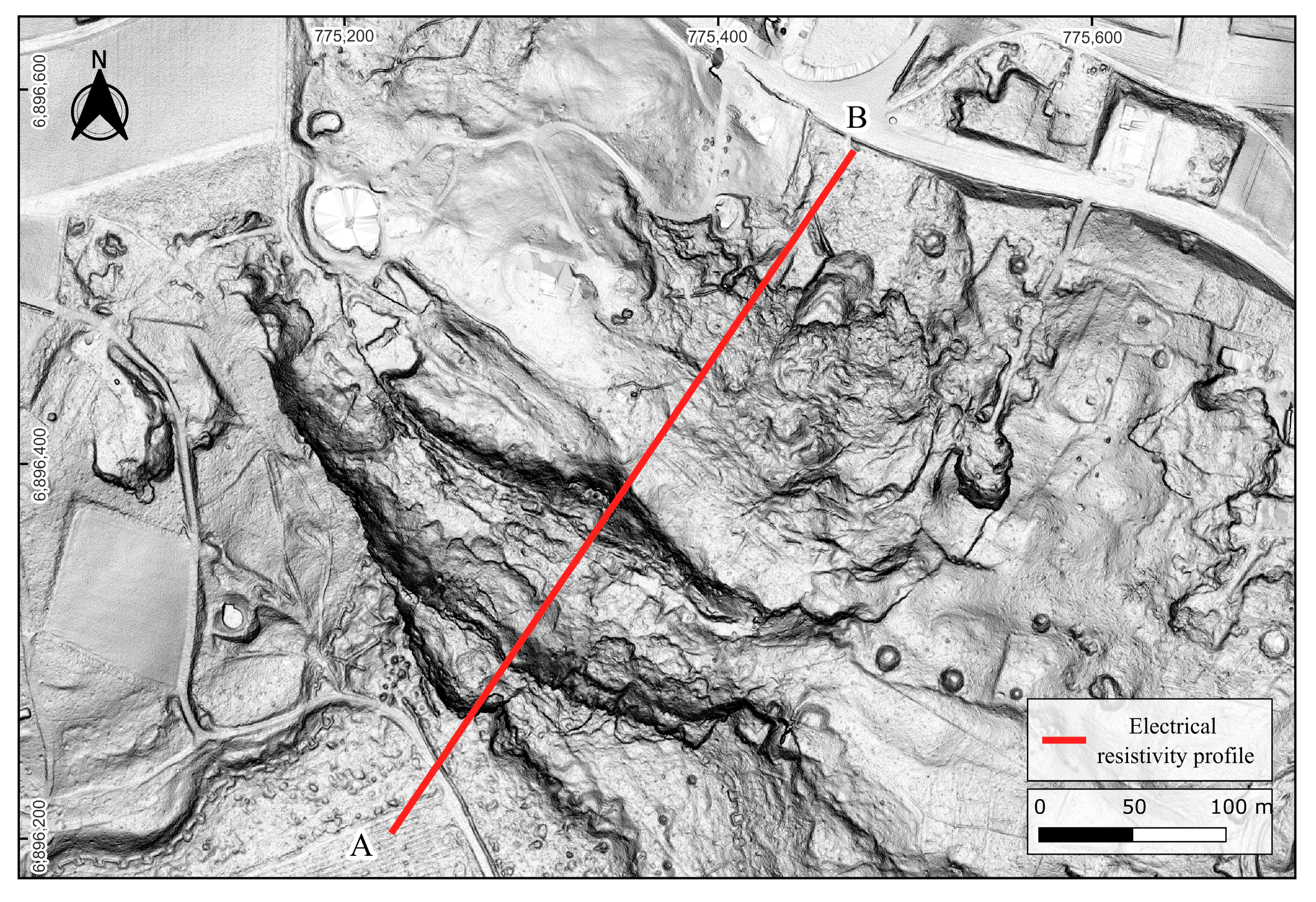
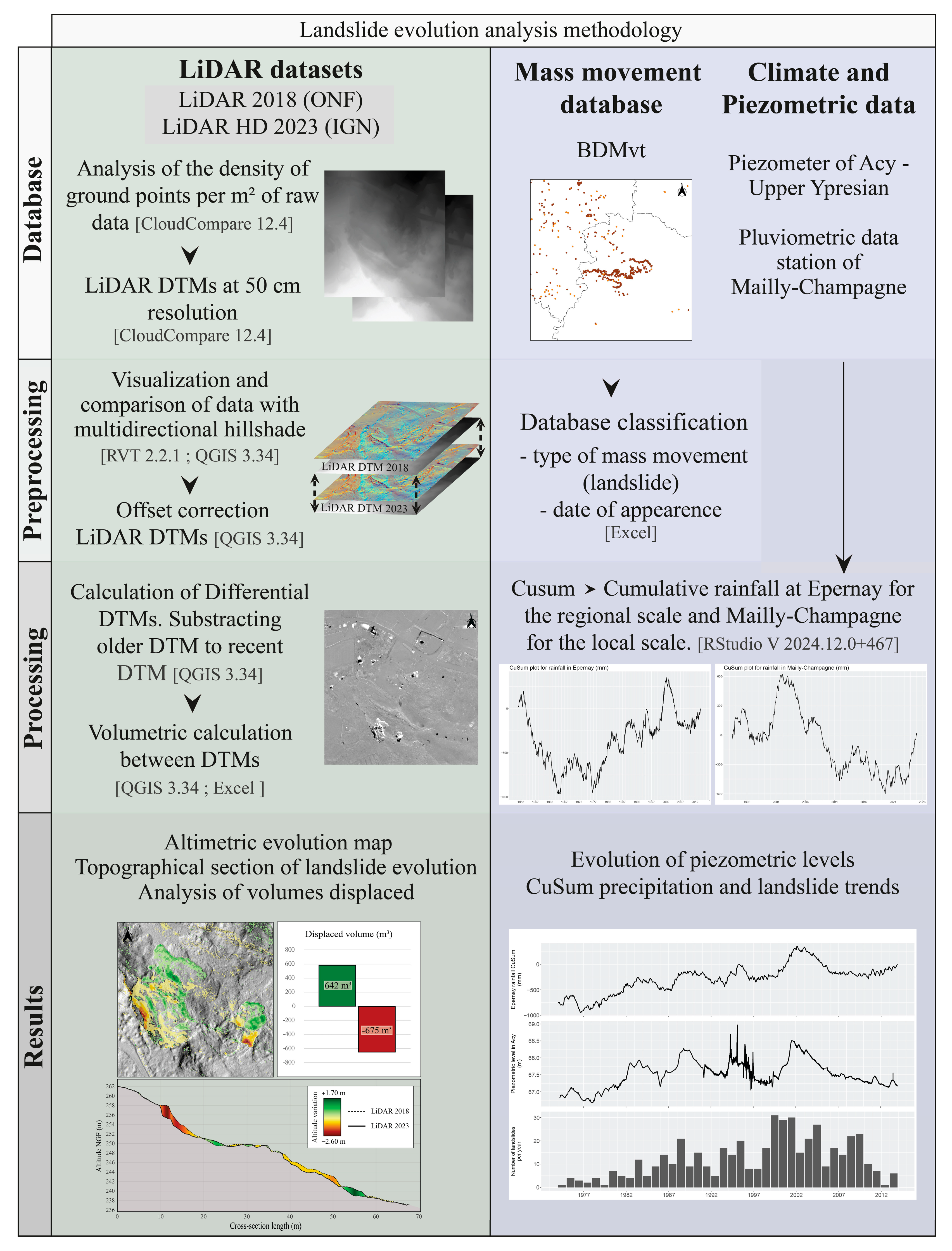


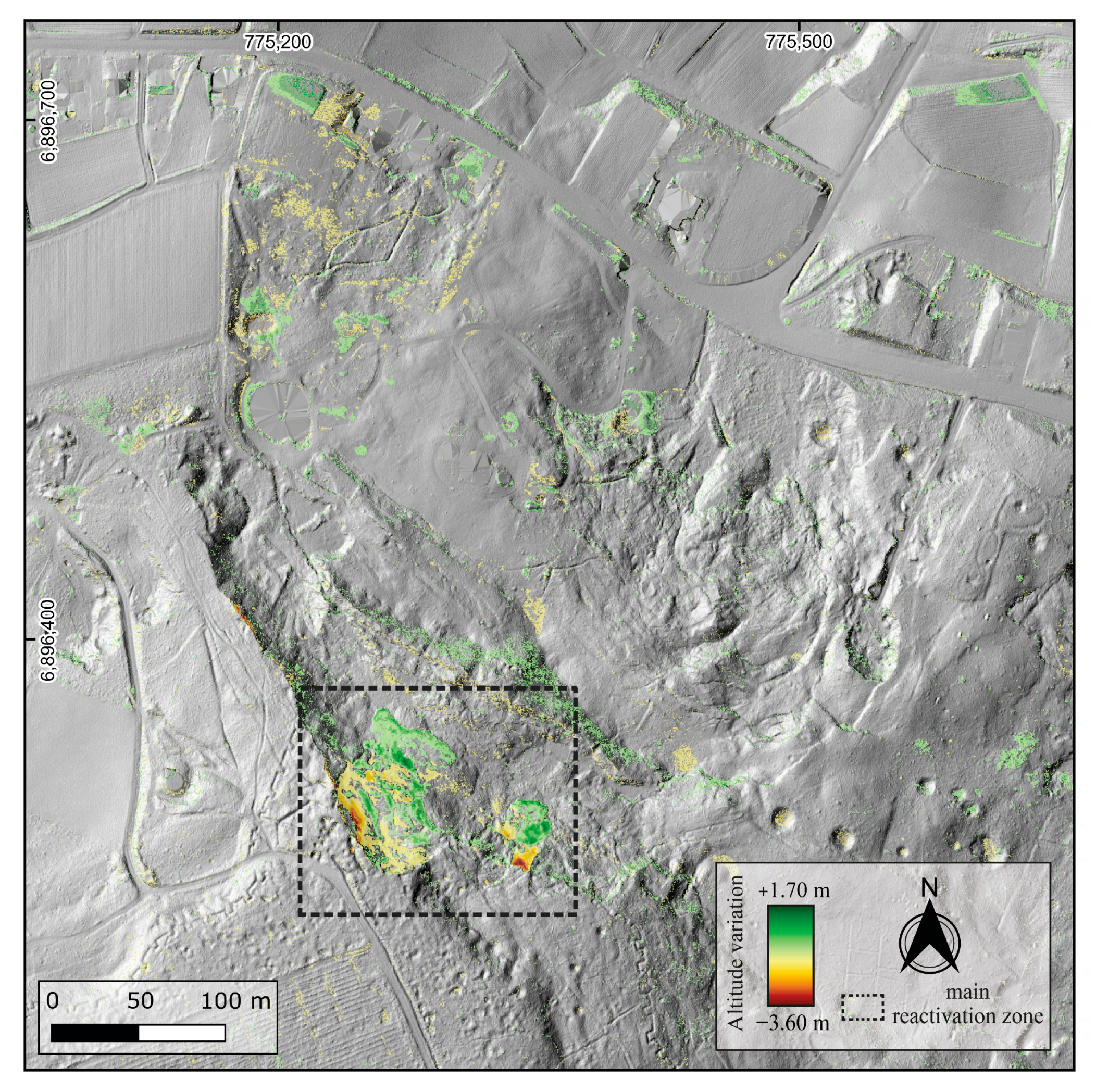
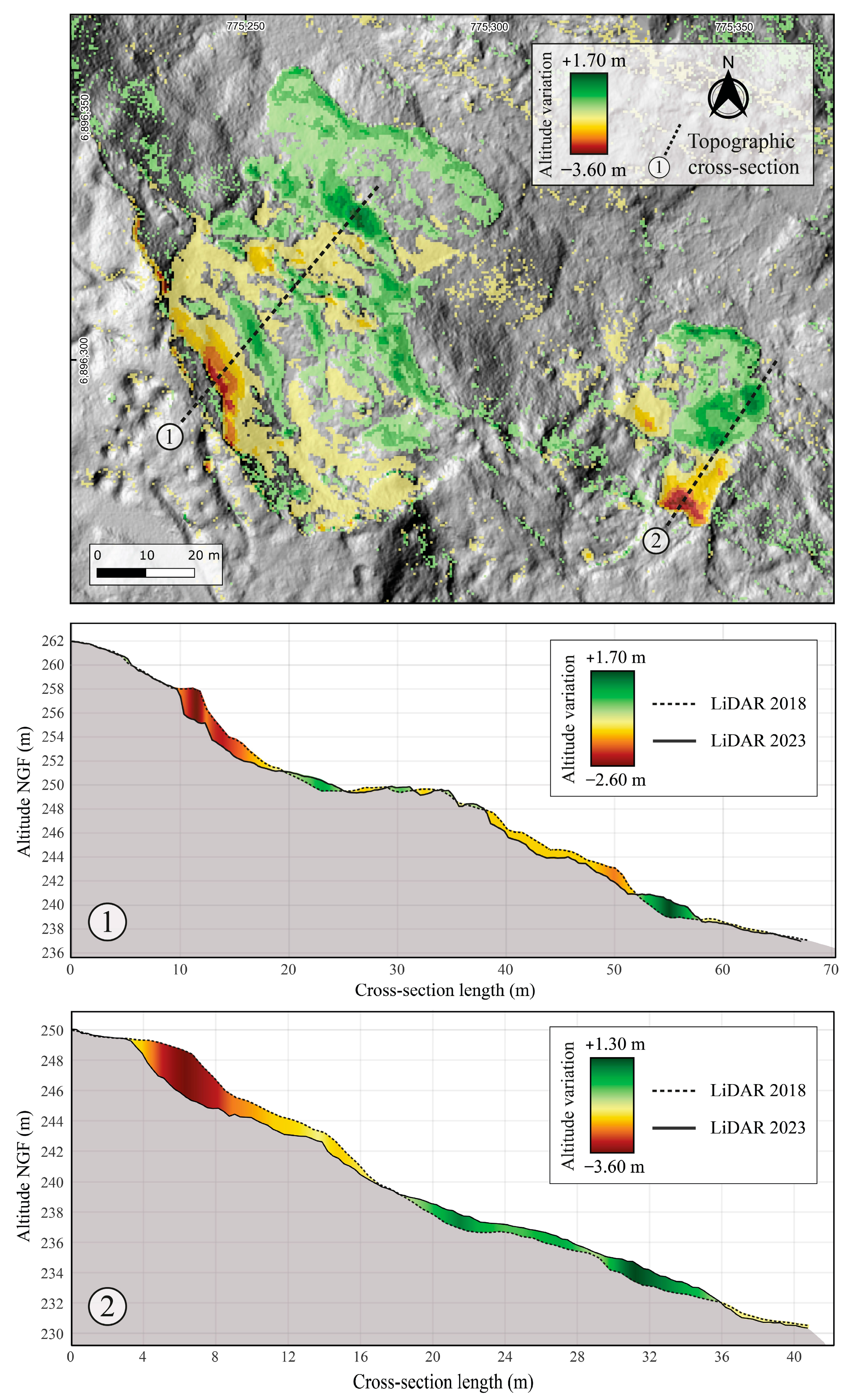
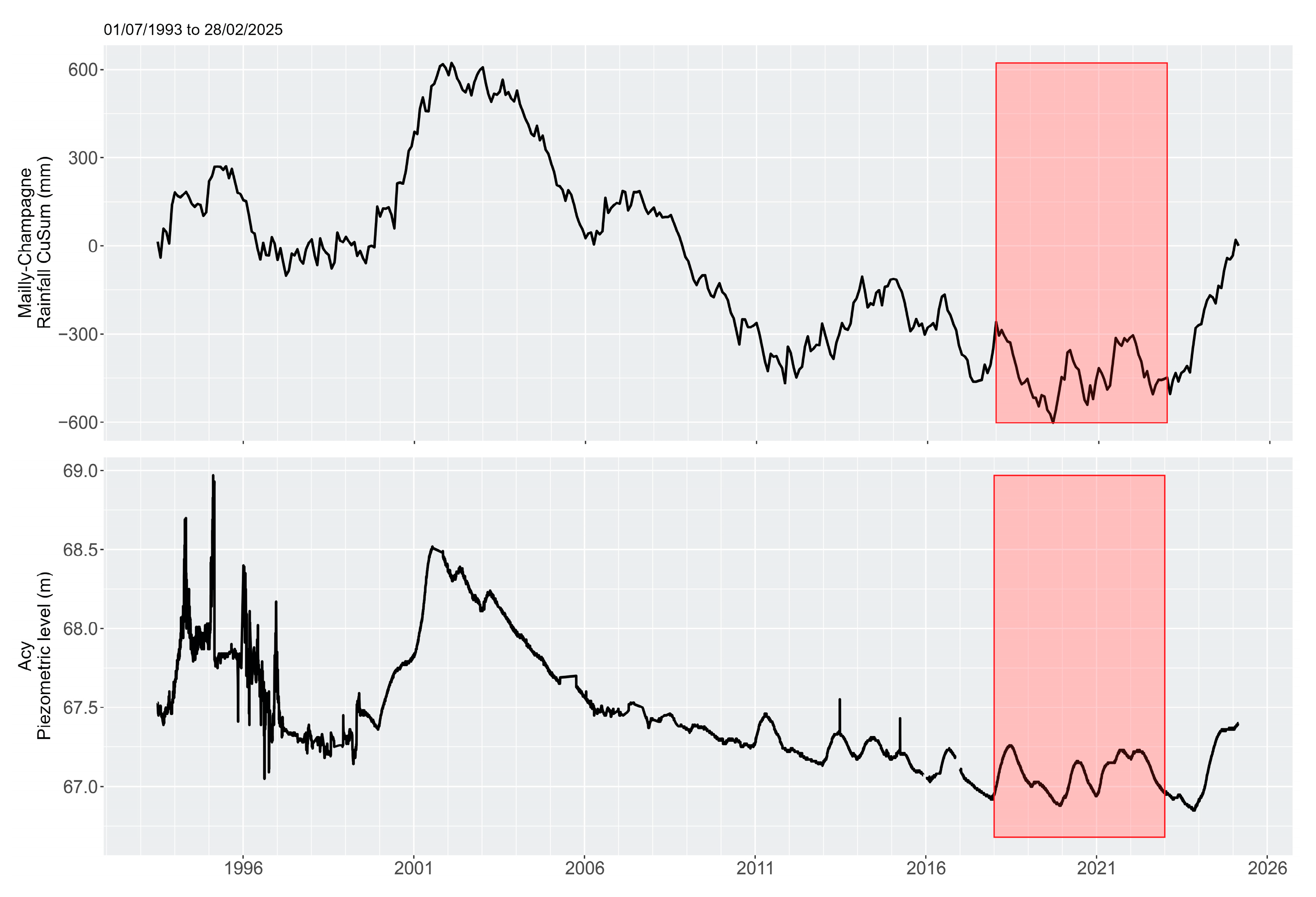
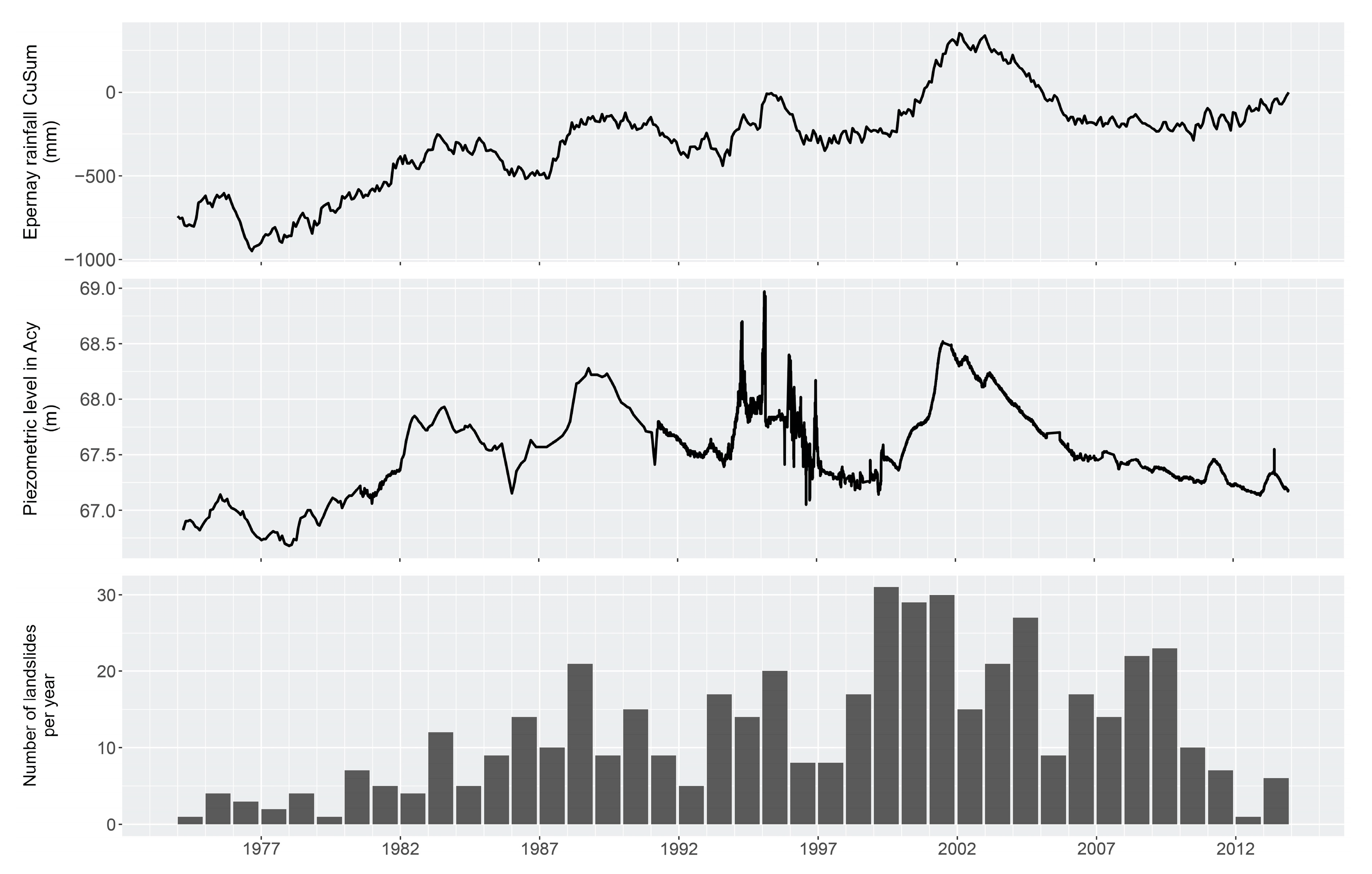
| Age | Facies | Elemental Composition of Minerals | Plasticity Index of Atterberg (%) | Cohesion (kPa) | Angle of Internal Friction Cassangrande box (°) | Average Water Content (%) |
|---|---|---|---|---|---|---|
| Rupelian | Mudstones clays | Montmorillonite, illite, kaolinite | 75 | 24 | 17 | 26.6 |
| Lutetian | Limestones and marls | Montmorillonite, illite, attapulgite | 75 | 25 | 28 | 36.8 |
| Lower Ypresian | Clays, lignites | Montmorillonite, illite, kaolinite | 75 | 11 | 26 | 39.5 |
| LiDAR 2018 (ONF) | LiDAR HD 2023 (IGN) | |
|---|---|---|
| Acquisition date | 21 to 23 February 2018 | 17 March 2023 |
| Laser | Riegl LMS Q680 I | RIEGL VQ 1560 II |
| Ground point density | ||
| Number of points per m2 | Covered area (%) | |
| NoData | 1.2 | 1.7 |
| 1–5 | 2.1 | 1.3 |
| 5–10 | 16.7 | 2.8 |
| 10–15 | 46.8 | 12.1 |
| 15–20 | 28.8 | 60.4 |
| >20 | 4.4 | 21.6 |
| LiDAR data accuracy | ||
| Precision Z | 10 cm | 10 cm |
| Precision Y | 25 cm | 50 cm |
| Weather Station | Mailly (CIVC) | Epernay (CIVC) |
|---|---|---|
| No. station | 51338001 | 51230001 |
| First measure | January 1976 | January 1820 |
| Last measure | March 2025 | March 2025 |
| Geographic coordinates—Lambert 93 | ||
| Altitude (Z) | 182 m | 90 m |
| Longitude (X) | 781,697 | 773,123 |
| Latitude (Y) | 6,896,161 | 6,881,953 |
| Evolution | Reactivation 1 | Reactivation 2 |
|---|---|---|
| Erosion volume (E) | 675 m3 | 228 m3 |
| Accumulated volume (A) | 642 m3 | 201 m3 |
| Surface affected (S) | 4525 m2 | 944 m2 |
| Relative evolution ([E+A]/S) | 0.29 | 0.45 |
Disclaimer/Publisher’s Note: The statements, opinions and data contained in all publications are solely those of the individual author(s) and contributor(s) and not of MDPI and/or the editor(s). MDPI and/or the editor(s) disclaim responsibility for any injury to people or property resulting from any ideas, methods, instructions or products referred to in the content. |
© 2025 by the authors. Licensee MDPI, Basel, Switzerland. This article is an open access article distributed under the terms and conditions of the Creative Commons Attribution (CC BY) license (https://creativecommons.org/licenses/by/4.0/).
Share and Cite
Bollot, N.; Benoit, A.; Berthe, J.; Combaz, D.; Krauffel, T.; Devos, A.; Lejeune, O.; Ancelin, P.-Y. Analysis of the Evolution of Lowland Landslides in Temperate Environments According to Climatic Conditions Based on LiDAR Data: A Case Study from Rilly (Champagne Vineyard Region, Northeastern France). Geosciences 2025, 15, 191. https://doi.org/10.3390/geosciences15060191
Bollot N, Benoit A, Berthe J, Combaz D, Krauffel T, Devos A, Lejeune O, Ancelin P-Y. Analysis of the Evolution of Lowland Landslides in Temperate Environments According to Climatic Conditions Based on LiDAR Data: A Case Study from Rilly (Champagne Vineyard Region, Northeastern France). Geosciences. 2025; 15(6):191. https://doi.org/10.3390/geosciences15060191
Chicago/Turabian StyleBollot, Nicolas, Auguste Benoit, Julien Berthe, Delphine Combaz, Théo Krauffel, Alain Devos, Olivier Lejeune, and Pierre-Yves Ancelin. 2025. "Analysis of the Evolution of Lowland Landslides in Temperate Environments According to Climatic Conditions Based on LiDAR Data: A Case Study from Rilly (Champagne Vineyard Region, Northeastern France)" Geosciences 15, no. 6: 191. https://doi.org/10.3390/geosciences15060191
APA StyleBollot, N., Benoit, A., Berthe, J., Combaz, D., Krauffel, T., Devos, A., Lejeune, O., & Ancelin, P.-Y. (2025). Analysis of the Evolution of Lowland Landslides in Temperate Environments According to Climatic Conditions Based on LiDAR Data: A Case Study from Rilly (Champagne Vineyard Region, Northeastern France). Geosciences, 15(6), 191. https://doi.org/10.3390/geosciences15060191






